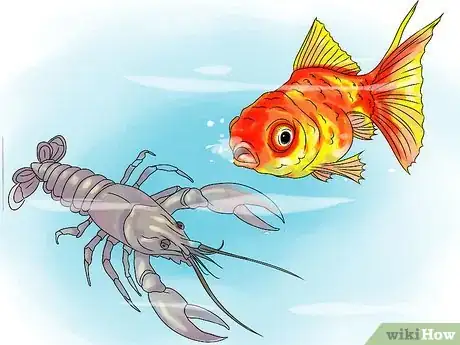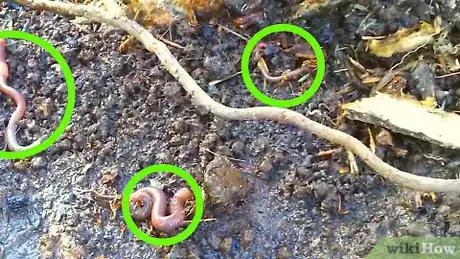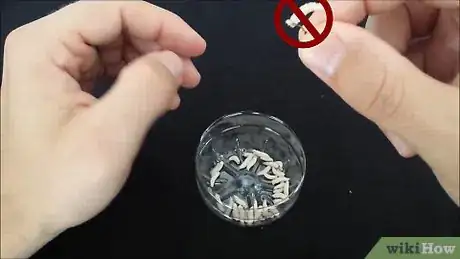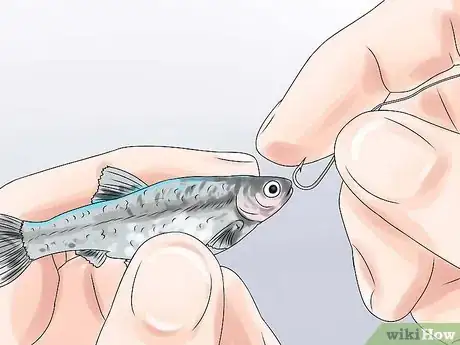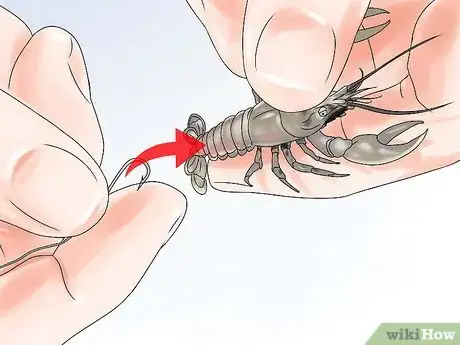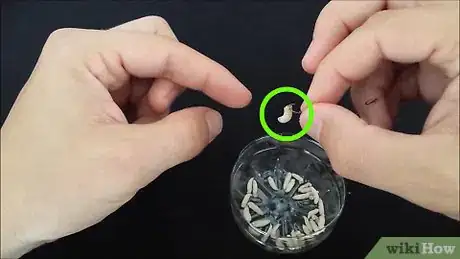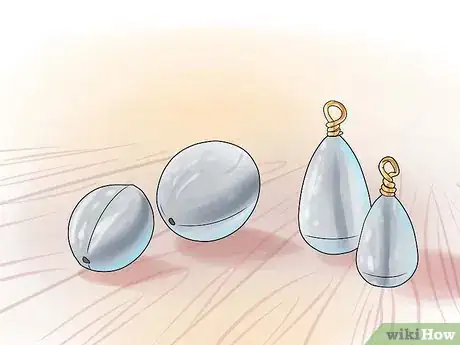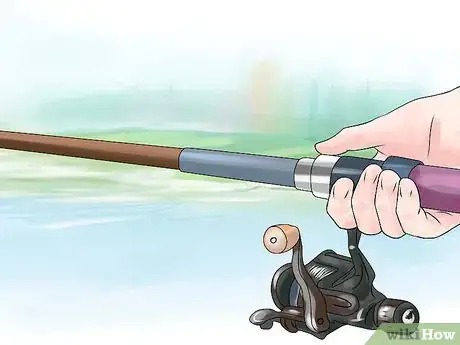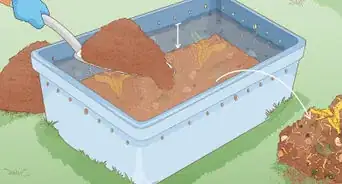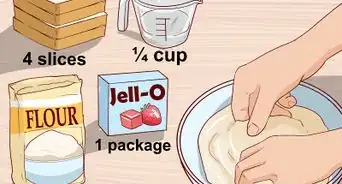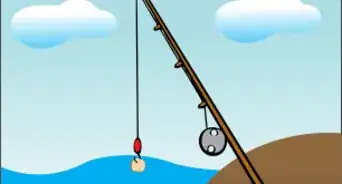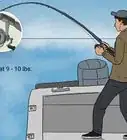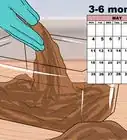X
wikiHow is a “wiki,” similar to Wikipedia, which means that many of our articles are co-written by multiple authors. To create this article, 13 people, some anonymous, worked to edit and improve it over time.
This article has been viewed 132,023 times.
Learn more...
Sometimes fish just want live bait. You can learn how to rig live bait on a simple fish hook, as well as the best practices for ensuring that your quarry are interested. Techniques and hooks will vary according to the type of fish you want to catch and the bait available to you, but the basic principles are the same across the board. Proper rigging is easy to master with a little bit of cleverness and practice. See Step 1 for more information.
Steps
Part 1
Part 1 of 2:
Catching and Keeping Live Bait
-
1Learn the live bait fishing regulations in your area. In some areas, especially in the Northwest, fishing with live bait is restricted to particular varieties of bait and particular waters. Bait fish, for instance, are often illegal in rivers in Washington and Oregon. Double-check to make sure it's legal to fish with the kind of bait you intend to use by checking with the state department of Fishing and Wildlife in your area.
-
2Select a variety of live bait, or choose from what's available. The right kind of live bait depends completely on where you fish, what you're fishing for, and what's available. If you've got an infestation of grasshoppers, don't waste time trying to catch up a bunch of minnows to go fishing. Get rid of your pests and find some bait at the same time.[1] Common live baits include:
- fathead minnows
- goldfish
- loach
- nightcrawlers
- rat-tailed maggots
- corn borers
- grasshoppers
- crayfish
- small salamanders or frogs
Advertisement -
3Keep your bait alive. Find a small habitat for your live bait to keep them alive until you're ready to set out fishing. Make sure there's enough moisture and air circulation, and any leaves or bits of grass for them to feed on until you're ready to fish. Try not to keep them in there for more than a day or two, or they may die. Worms will be fine in some fine moist earth for a longer period.
-
4Wait to rig your bait until you are about to cast. The whole point of using live bait is to keep it alive as long as possible into the fishing process, so the wriggling attracts fish. If you rig your hook too early, your bait will be dead by the time you get it in the water. Keep it close by and get your hook on the line, get set up, and get ready to fish.
Advertisement
Part 2
Part 2 of 2:
Rigging Live Bait
-
1Remove your bait from the habitat securely. This is easier said than done with bait fish. If you're fishing with minnows, getting a hold of one is more than half the battle. Pull bait-fish from the bait tank by grasping it firmly and preventing it from squirming. Get a good grip on it with one hand and bring your hook in with the other.
-
2Hook bait-fish through the body behind the dorsal fin. You can often insert your fish hook in one smooth motion either just behind the dorsal fin, then cast immediately and gently, letting the bait fall into the water as easily as possible to keep it alive.
- Alternatively, hook bait-fish through the lips and jaw so they'll live longer. The position behind the dorsal fin is often most secure, but causes the bait to tire out quickly and die fast. Inserting the fish hook through the lips makes it more likely that the fish will not drown quickly, but will cause it to move more awkwardly through the water. Inserting the hook through the nostrils will keep the bait alive as long as possible, but is riskier, as the fish may escape.
-
3Hook crayfish, salamanders, and frogs through the tail or through the head. Like bait-fish, crayfish give you a number of options for hooking them. Make sure you go deep enough into the tail and close enough to the torso to get a good grip on the crayfish, to avoid losing the bait to wriggling. If you go through the head, you'll get a secure grip but the bait won't last as long.
- For salamanders and frogs, go through the torso near one of the back legs. They'll still put up a good amount of wriggling, but it'll be difficult for them to wriggle off the hook.
-
4Hook worms, caterpillars, and grubs by bunching them up. Start close to one end of the worm, folding it back over on itself multiple times--at least 3--to secure the worm or other wriggler snugly on the hook.
-
5Hold the bait firmly while preparing to cast. Make sure you don't lose your bait before you get it in the water. Hold onto it gently as you prepare to cast, and cast gently into the water where you want it to go. Do it quickly, but gently.
-
6Use a split-shot rig with a sinker. To keep the live bait at an appropriate depth and control the line for the kind of fish you want to catch, it's usually common to rig your line up with a split-shot sinker to weight things down.
- Alternatively, grasshoppers and other lighter insects might be more appropriate to let float on the surface, depending on what it is you're fishing for. If you want it to float, leave the sinker off.
-
7Keep a light touch on your line. Remember not to tug too strongly on the fish hook. Proper rigging requires you to keep the bait as healthy as possible before casting it in the water. Happy hunting!
- Remove dead bait if you are not successful and rig again. Try to troubleshoot any problems you may have had with the last bait and adjust hook position accordingly.
Advertisement
Community Q&A
-
QuestionHow do I hook live bait with a barbless hook?
 Community AnswerYou could put a colored marshmallow on the end of hook behind bait. The stickiness of the colored marshmallow clings to the hook and does not let the live bait to slide off.
Community AnswerYou could put a colored marshmallow on the end of hook behind bait. The stickiness of the colored marshmallow clings to the hook and does not let the live bait to slide off. -
QuestionHow do I find worms for kids?
 Community AnswerCheck your garden for worms. You may have to do a little digging which adds to the fun. No garden? Take a nature hike in the woods or field and turn over rocks and logs.
Community AnswerCheck your garden for worms. You may have to do a little digging which adds to the fun. No garden? Take a nature hike in the woods or field and turn over rocks and logs.
Advertisement
Warnings
- Don't add too many sinkers or other accoutrement to your hook. The idea is to convince your quarry that they're chasing live prey; anything that interferes with that image will hurt your chances of success.⧼thumbs_response⧽
Advertisement
Things You'll Need
- Live bait
- Bait tank
- Fish hook
References
About This Article
Advertisement
